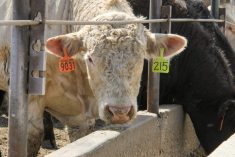Glacier FarmMedia—Some pulse crops in Saskatchewan are slightly behind schedule in their development, but growing conditions are better than last year, according to Saskatchewan Pulse Growers (SaskPulse) executive director Carl Potts.
While cooler temperatures and near-constant rainfall over much of the province delayed seeding and crop development, the growing season is off to a good start.
“It’s certainly nice to see seeding going in with good moisture conditions in some areas of the province after years of drought conditions,” Potts said.
Read Also

U.S. grains: Chicago grains firm as traders gauge China purchases
Chicago | Reuters – Chicago soybean futures ticked up on Wednesday as traders eyed Chinese purchases of U.S. beans under…
As of June 10, seeding was 98 per cent complete in Saskatchewan according to the province’s weekly crop report. Also, 79 per cent of pulse crops were in normal development, while 19 per cent were behind and two per cent were ahead. Lentils were rated 90 per cent good to excellent, while chickpeas were rated at 95 per cent. Field peas were rated at 91 per cent good to excellent, while soybeans were at 83 per cent.
“We’re expecting (field) pea and lentil acres to be up 12 to 15 per cent … Chickpeas are probably up 25 per cent. I think strong prices have really driven more acres, but it’s still a little bit early to tell to see which crops are faring better than others,” Potts said.
However, excess moisture can result in flooding in low-lying areas and bring additional pressure to crops, including the threat of disease.
“June is a time when we start to see root disease with a little bit more moisture,” Potts said. “We’re waiting to see how prevalent root disease, particularly aphanomyces, will show up in pulse crops in wetter conditions. That’s a bit of a wait-and-see. As of now, I think good moisture conditions are really useful to get those crops higher off the ground.”
He heard from farmers and SaskPulse board members that conditions were ideal in eastern parts of Saskatchewan, while the southwest was still coping with the additional moisture.
“I hope the warmer weather will come and we can get those crops grown,” Potts added.
Demand has been strong for Saskatchewan pulse crops in the international markets, Potts mentioned, citing examples including higher prices for lentils and peas as well as saying there was little unsold inventory remaining on farms.
With moisture already in good supply, Potts is hoping for the sun and the heat if there’s going to be an ideal growing season.
“I think what we need is a break in the rain cycle in some areas and some good warm 25 (to) 28 degree (Celsius) days to get those crops moving,” he said. “And then, of course, we need some timely rains in July to get the crop closer to harvest.”
















